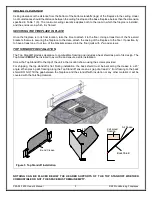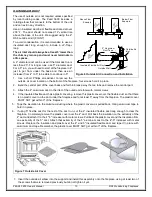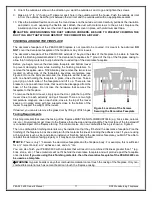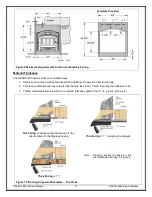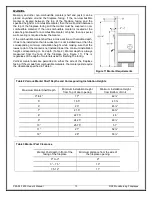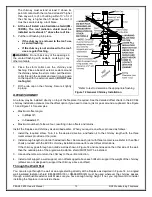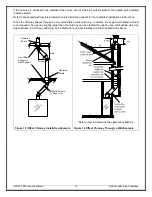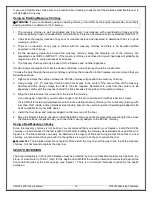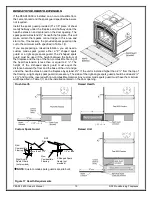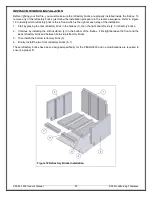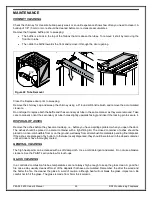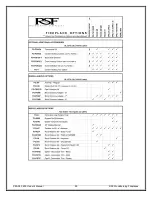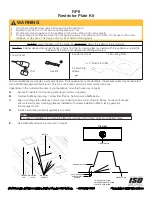
PEARL 3600 Owner's Manual
23
RSF Woodburning Fireplaces
FUEL
All modern high efficiency fireplaces and woodstoves are designed to burn best with seasoned cordwood. Seasoned
wood can be defined as wood that has been cut, split and let dry under cover for a minimum of 6 months, preferably
a year or more. Dry seasoned wood generally contains less than 20% moisture content. Attempting to burn fuel
with a high moisture content will be difficult and result in lower efficiency, increased creosote buildup and dark
deposits on the glass. It’s possible to burn a very large amount of wood and get very little heat if the wood is wet.
The type of wood you select is also important. All types of wood give off more or less the same number of BTU’s
per pound. Since softer woods are less dense than hardwoods it is possible to put more weight of hardwood in the
firebox; in other words, all woodburning appliances will burn longer and more evenly with hardwoods. Never burn
scrap, garbage, treated wood or driftwood as they produce much more pollution and can corrode the firebox and
chimney as well. Burning large amounts of paper, cardboard, mill ends, or construction waste can easily over fire
and damage the fireplace or even ignite a chimney fire if the flue is dirty.
We do not recommend using wax fuel logs (e.g. Duraflame) in this fireplace because it will dirty the glass. If you
choose to use them, do not use more than one at a time and do not poke or stir while it is burning. Use only firelogs
that have been evaluated for fireplace use. In Canada, they must meet the requirements of ANSI/CAN/UL/ULC
2115, Processed Solid Fuel Firelogs and Firestarters. Refer to the firelog warnings and caution markings on
packaging prior to use.
WARNING:
Burn dry wood only.
Do not burn: driftwood, treated wood, coal, garbage, or plastic.
FIRST FIRES
You will experience a slow start-up during the first few fires. The refractory bricks lining the firebox contain moisture
from manufacturing and require a few hot fires to evaporate the moisture. While there is still moisture in the bricks,
they will be black with smoke deposits. When the moisture has dissipated, the bricks will turn white. Unlike cast iron
stoves, there is no need to cure the fireplace itself by starting with small fires and progressively larger ones. Feel
free to light a large fire from the very start.
You will experience a slight odor during the first few fires. This odor comes from curing paint and oil burning off the
metal. The odor may be strong enough to set off your smoke detector. Open the doors and windows to allow the
room to properly ventilate.
REFUELING
Have your next wood load ready when you open the door. The temperature in the firebox will decrease as the door
is open, so decreasing the amount of time the door is open will allow the firebox to remain hot. Do not rush.
Turn off the fans, if installed. The fans may cause smoke to spill out of the fireplace if they are running.
The door should be opened slowly to keep smoke from spilling into your room. If you have a problem with smoke
spillage, check to see that all kitchen and bathroom fans have been shut off. They can cause negative pressure in
the house which pulls smoke out of the fireplace.
Take the time to poke and stir the unburnt wood that is left in the firebox. This will help revive the fire. Place the
new logs in the firebox. Try to maintain a clear a path in front of the pilot, which is the metal tube centered at the
front of the firebox. The pilot brings an influx of air close to the coals that will help to keep the fire going. Once the
new wood has been loaded, keep the door slightly ajar for a couple of minutes to get the fire going depending on
how well seasoned your cordwood is and how much coals were left in the firebox. Once the new wood it well lit,
close the door.
You can now adjust the combustion air control according to your needs.
If you have an internal blower installed,
•
wait about 45 minutes after reloading before you start the blower again if you have the combustion air
control set to anything between half-way to minimum.
•
wait about 20 minutes after reloading before you start the blower again if you have the combustion air
control set to anything between half-way to maximum.

